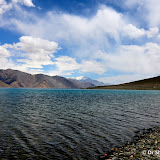Historically, the region included the Baltistan (Baltiyul) valleys, the Indus Valley, the remote Zangskar, Lahaul and Spiti to the south,Aksai Chin and Ngari, including the Rudok region and Guge, in the east, and the Nubra valleys to the north.
Contemporary Ladakh borders Tibet to the east, the Lahaul and Spiti to the south, the Vale of Kashmir, Jammu and Baltiyul regions to the west, and the trans–Kunlun territory of Xinjiang to the far north. Ladakh is renowned for its remote mountain beauty and culture. It is sometimes called "Little Tibet" as it has been strongly influenced by Tibetan culture.
Ladakh being a strategic location from military angle was closed to visitors till 1974. Ladakh region includes the districts of Leh and Kargil. Ladakh is a high altitude cold desert .
Leh town is the hub of all activities in Ladakh. Leh is connected by air to Delhi,Jammu and Srinagar with daily flights to and from Delhi. By road Leh can be reached by two routes one from Manali and other from Srinagar via Kargil. Both these places are around 440 Km s from Leh and need two days of travel through high mountain passes. These roads open only during summer and peaks receive snow fall even in summer. Leh is at an altitude of around 11500ft above sea level. The co ordinates of Leh are
| 34° 8′ 43.43″ N, 77° 34′ 3.41″ E. The main tourist attraction of Ladakh are the beautiful landscapes ,historic and pictursque monasteries , High altitude lakes with crystal clear waters, snow peaks , vibrant culture and religion of Ladakh. Leh town has an ancient palace belonging to Numgyal dynasty and a monastery . Thikse monastery and shey palace are about 10 km from Leh . The sangam of Zangskar and Indus river, Sindhu ghat, a museum of Kargil war at Hall of fame Gurudwar pattar saheb, Spituk monastery ,Shanti stupa are the places worth seeing at Leh. Nubra valley is a region to the north of Leh with the Nubra river and has famous Diskit monastery. Nubra has a landscape with white sand dunes and snow capped mountains the combination of which is unique to Ladakh.While drive to Nubra valley invoves excursion on world's highest road at Khardung La (18380 ft) . Ladakh has several high altitude salt water lakes .Famous few are Pangong lake ,Moriri lake, Kar lake. |
Ladakh is a beautiful place ,dark blue sky,white clouds, blue water, colorful prayer flags , monasteries atop tall hills, Snow capped mountains, sand dunes, curving serpentine roads, smiling Ladakhi Budhists, prayer wheels ,stupas all make this land serene and Gods own place. If you are a photography enthusiast and want to make all forms of photography in one go Ladakh is the place. You can have great landscapes, beautiful birds, amazing wild life ,portraits of some of the smiles which you will ever remember , action, night and time lapse photos , structures and monuments everything in one trip Ladakh is undoubtedly the place.
Of the several places I have travelled in India and abroad Ladakh is the place which has left an indelible mark in my memory. Ladakh is not just about photography ,it is not just about holiday travel ,it is beyond all these which makes it special. It is about a place which has stood all adversities ,it is about a human race which stood against time,. against all difficulties and yet bear an inimitable ,genuine smile on their face.
In the following few photos I have included a glimpse and divided my web album into different segments and given link to them separately.Please visit all the albums and in every picture I have included some small details.
Ladakh is too big for any camera to capture.
Every inch of the land is photogenic and most of it is best enjoyed by our eyes and it will be indelibly recorded in your memory.Photos are only to show to others a glimpse of our journey into this great land of Lamas.
| Khardung La road |
| Shanti stupa at Leh |
| Thikse monastery, Click on the image below to visit my web album Ladakh Landscapes |
 |
| Ladakh landscapes |
 |
| Ladakh Monastery |
 |
| Ladakh birds and wildlife |
 |
| Ladakh trivia |



